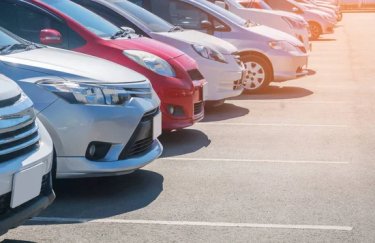“`html
-

Halyna Panchenko
Content Director

Taras Getmansky, the CEO of Getmancar. Image: provided by the company’s press department.
In the nation of Georgia, they succeeded leveraging older vehicles. They navigated the Romanian environment, where rival firms from Europe succumbed. Furthermore, in Germany, they opted for a “David versus Goliath” approach, incrementally conquering the sector in specialized segments unnoticed by larger enterprises. In a discussion with Delo.ua, Getmancar’s originator, Taras Getmansky, unveiled his international growth blueprint.
How did the incursion impact your organization?
— Prior to the hostilities, our inventory contained 500 vehicles, yet not all were held outright by the firm. Approximately 65–70% were under our ownership. Some financiers withdrew during 2022–2023, as a significant number relocated abroad. However, we rebounded, securing fresh backers.
We currently maintain roughly 700 cars, with about 500 owned by us. This February, we tapped into a fresh marketplace — Lviv. This marks our third municipality and operates via a franchise framework. We didn’t enter independently; our ally chose to cultivate the venture in collaboration with us. He’s a modest businessperson, experienced in vehicular leasing. We aided with the vehicles, resulting in a mixed strategy. It’s progressively evolving.
Initially, we deployed about 23–25 vehicles in Lviv, which has now expanded to 40, with an additional number of over 50 counting our vehicles. Both car sharing and leasing activities are available there.
What’s the situation with your earnings? At the dawn of the war, you recorded approximately 88 million UAH in 2022. Has this escalated since then?
— Indeed. There’s advancement, though I won’t share the specific figures.
Within your array of offerings, you encompass rentals, leasing, and vehicular sharing. Which generates the bulk of your income?
— Correct, we’re augmenting the commercial divisions. There exist multiple avenues: taxi rentals, leasing arrangements, car sharing, and subscription services. To us, these represent supplementary sectors that we’ve consolidated beneath a singular brand name. Car sharing accounts for the majority of earnings, surpassing 90%.
In 2023, you broadcasted a shift in strategy, aiming to attract individual backers. What prompted this?
— Even prior to the war, our intention was clear: to ensure that 70–80% of our vehicles were owned by private financiers. Back then, we evaluated the market at several thousand vehicles.
Your webpage for individual backers specifies a 16% yield. What is the realistic return?
— On average, it ranges from 23–26%. Various strategies exist, so the figure can fluctuate from 12% to 42% in hard currency. The hryvnia’s stability has improved; any variations fall within the acceptable margin of inaccuracy.
At times, financiers regard Ukraine as excessively precarious, yet do you perceive Ukraine as a trustworthy locale for funding?
— Without question. It represents one of the finest nations for commerce: resilient individuals, a robust marketplace. We should value this and forge our own nation.
Then, let’s assess the Ukrainian sector against those of other nations where you operate. Which is exhibiting the greatest vigor currently?
— Moldova. It stands as one of the preeminent markets for franchise escalation. In 2023, it surged between 140% and 360% across diverse indicators — vehicle inventory, earnings, client figures. They now manage over a hundred vehicles. We collaborate with a sole franchisee there, who proactively sought a partnership. The individual had prior involvement in the rental realm. The procedure was deliberate — we conversed for roughly nine months ahead of launching our collaboration. Approximately a hundred vehicles are operational there presently.
What are the forecasts for its advancement in the forthcoming annum?
— Our ambition is for it to double. Yet, this hinges upon both our aspirations and their own resolve, along with a readiness to привлечь outside capital. They’ve already fielded numerous requests to expand their fleet size.
What contrasts exist between the Moldovan and Ukrainian marketplaces?
— Ukrainian and Moldovan patrons exhibit resemblances in conduct and journey characteristics. Discrepancies manifest in time intervals and typical expenditures, varying in each context. The Georgian sector diverges considerably — nearly 50–100% disparate from its Ukrainian and Moldovan counterparts.
Share insights about Georgia. Your presence there extends back to 2014. What’s your market standing?
— At this point, we remain the exclusive operator. It constitutes a singular sector, evolving according to unique norms. The year 2014 marked our introductory endeavor into a foreign rental marketplace and, frankly, the conception arose due to office losses, Crimea, sections of the Luhansk and Donetsk regions, an 80% plunge in the Ukrainian rental sector, and the shrinkage of tourism. It proved exceedingly challenging; we nearly ended our maiden year in insolvency, yet we persevered.

Georgia hasn’t surrendered to “Hetmankar” for the first instance. Image: provided by the company’s press department.
Why specifically Georgia?
— “Providence had its hand in it”: a collection of detached indicators and associates, a hasty exploratory inquest — revealed a niche. They approached with Ukrainian methods — yet it failed. They adapted their methods — and progress ensued.
What differentiates the “Ukrainian” approach from the “Georgian” one?
— Benchmarks for vehicular grade. Ukrainians exhibit higher expectations: we source numerous “American” models, but refine them appropriately. In Georgia, for an extended period, vehicles lacking specific safety mechanisms were deemed commonplace; a vehicle spanning 12–14 years could be lauded as “new”. When, in Georgia, we endeavored to operate solely with contemporary, proprietary vehicles, we became uncompetitive due to elevated devaluation. We adjusted our strategy — which drastically enhanced financial outcomes, simply by curtailing expenditures. In summary: “imposing one’s ethos in another’s domain” — proves unfruitful; grasping the local transport consumption culture is imperative. Currently, the Georgian sector has undergone considerable advancement concerning vehicular quality, as opposed to 2014, and bears greater likeness to its Ukrainian counterpart.
What’s your present vehicular count in Georgia, and which urban centers are encompassed?
— Approximately 120. Vehicle sharing is accessible in Batumi and Tbilisi, while leasing operates across three urban centers. In effect, we additionally serve Kutaisi through Kopitnari Airport (as the municipality itself lacks parking provisions). We partner with a single franchisee in this locality. He manages approximately 35% of the vehicular collection. We reinforced him with transport assets from the leasing division, pooling resources. The franchise system emerged thereafter; previously, we maintained 2–3 brand names, now we’re unifying everything under Getmancar — thus reducing team and operational costs. A segment of the vehicular holdings comprises rental establishments, with franchisees forming another portion.
Which countries present higher revenue streams?
— For instance, in Europe, a “norm” might be ~4–4.4 journeys/vehicle/day with an average transaction of ~€10 (or 1.3–1.7 for selected operators). In the Emirates, ~0.8 journeys, but the transaction might average ~$150. Hence, 0.8×150 = $120 income per vehicle daily, as opposed to €44 in Europe. Thus, fewer journeys do not signify a less lucrative sector — the average outlay is paramount. The identical principle applies to Georgia and Moldova: comparison metrics vary.
Why did you opt to inaugurate services in Qatar? Because of a higher concentration of affluent clientele there?
— Our focus shifted toward the Arab marketplace; Qatar constituted the initial locale where we promptly identified a collaborator. Currently, it adopts a rental arrangement, a collaborative venture as opposed to a franchise structure. We earn a commission, yet the accord varies: it may be lesser or greater, conditional upon the distribution of responsibilities and stipulations pertaining to safeguarding measures, software platforms, and oversight.
Switching our attention to Romania. You maintain representation across numerous municipalities there. Is this vehicle sharing?
— No, leasing. Our situation mirrors Qatar to some extent: a cooperative undertaking. We stand on the precipice of a conceivable vehicle-sharing launch, yet apprehension lingers in the sector — as evidenced by the sequence of bankruptcies among 3-4 operators. A Baltic operator even deserted Romania for Bulgaria due to alterations in parking ordinances.
From your vantage point, does the degree of vandalism fluctuate across different nations? What’s your measured percentage?
— We institute a universal “return rate” (proportion of vehicles sustaining damages), which encompasses vandalism. The percentage registers high. I posit: surpassing 10%, albeit under 20%. The outcome is conditional on risk governance. Statistical evidence reveals that in territories like Austria or Germany, insurance frameworks can “cripple” vehicle sharing as a business model.
Do insurance strategies exhibit substantial variances among countries?
— Undeniably, and even among different urban centers. It parallels civil vehicle tax: Kyiv mandates one rate, while Zhmerynka imposes another. In Georgia, a compulsory “civil vehicle tax” has been non-existent for several years.
Where does insurance incur the greatest expense?
— In Germany, it’s appreciably pricier than in Romania: spanning from €250 to €450 monthly per vehicle. Potential earnings can reach €30–50 each month from the vehicle (before tax considerations). The sum appears diminutive, but the capital’s cost ultimately influences the outcome.

Despite global growth, Ukraine remains pivotal for Getmancar. Image: provided by the company’s press department.
Elaborate on the calculus: why does €30–50 represent the “norm”?
— Due to essentially cost-free funds. In Europe, the prevailing financing paradigm differs: interest payments typically suffice, eliminating the necessity to defray the core sum – with vehicle surrender transpiring at the term’s conclusion and devaluation accounted for by the financial institution. The mandate becomes “surpassing” the interest threshold. We acquired financing at ~4.43% (designated for German cargo vans intended for vehicle sharing). Under such economic conditions, the return on allocated capital maintains a highly alluring appearance, regardless of the monetary gain, albeit minimal.
Outline your German market status: three municipalities, collaborative partnerships, and vehicular numbers.
— Our engagement materializes through association with local allies — bearing resemblance to franchising but lacking adherence to the “classical” model. Roughly 50 vehicles constitute our German presence. The expansion primarily serves as a trial venture; the market bristles with rivalry, wherein numerous participants secure benefits (markdowns reaching 50% on vehicular acquisitions), which we progressively attain. Should one merely secure a 25–35% markdown, they risk forfeiting the depreciation contest.
What mechanisms are charted for augmenting growth in that region?
— Modest increments — “incremental strides.” Within each marketplace resides a delineated “perimeter” navigated by industry titans. While remaining outside of this sphere, we exploit elements evading scrutiny: specialized targeting, precise brand/configuration, client segments neglected by dominant players (for instance, Ukrainians lacking the “compulsory requisite” of a bank-issued card). Such conditions are routine for us; however, for large enterprises, they symbolize gratuitous and inessential risks, considering their considerable client base and market coverage.
What sums were expended to facilitate the venture in Germany?
— Modest outlays – tens of thousands of euros. “Infiltrating the perimeter” translates to ~€15 million annually simply to uphold a presence (exclusive of marketing investments). We judge this as ill-advised until compelling grounds substantiate a guarantee of triumph. Employing said €15 million for triumph across a spectrum of marketplaces presents a more appealing prospect than “existing” inside a single location.
How was a partner identified?
— A fraction of our workforce maintained a German foothold, engaging in dialogue with a local businessman, culminating in the verdict to proceed with a collaborative endeavor. The collaborator presented resources instrumental in furnishing advantages across funding mechanisms and marketing endeavors in designated sectors.
What constitutes your expansion matrix? Enumerate target nations.
— We entertain the notion of introducing our service in a supplementary European nation – the identity of which remains undisclosed. We are executing research, and indicators maintain an inviting essence, as do the partners in question. Prime attention remains on Moldova and Georgia; in Germany – governed by our current conceptualization. Romania and Qatar occupy the “second tier,” so to speak. Perhaps a separate market shall emerge to claim our premier designation or rapidly eclipse existing frontrunners.
To fathom market significance: What proportion of earnings presently emanates from Ukraine versus offshore markets?
— Ukraine retains its status as our foremost domain regarding vehicular holdings and collective performance. However, I speculate it accounts for roughly 50% or less of earnings. The residual ~50% originates from alternate markets.
What strategy directs the allocation of shares and earnings within each market for the upcoming year?
— Our aspiration is to cultivate several influential markets where we garner no less than the sum generated within Ukraine. Spanning six markets, our ambition is to witness Ukraine’s stake at ~1/6, diverging from the existing ~50%. Realizing this goal hinges on the expansion of vehicular holdings and strategic models.
Why sustain an international foothold if Ukraine forms your fundamental market base?
— It’s not related to “flight of capital.” Since 2014, it embodies a strategy to mitigate monetary and military risks: ensuring exchange rate instability doesn’t buffet the company with impacts of a similar magnitude encountered earlier. Nowadays, Ukraine has acclimatized to new exchange rates, and we affirm its potential for progress. International expansion reinforces the nation internally: personnel maintain their standing and competence within our Ukrainian enterprises, even when operating beyond Ukraine’s boundaries.
It’s pivotal for me to ensure we remain a Ukrainian enterprise, cultivating a resilient business framework. Upon the inauguration of the full-scale incursion, I voiced my regret to the team that we had failed to inaugurate a greater number of branches, enhancing protective capacities. Sustaining a 15-20% market dip precipitates pain; however, it pales in comparison to the 80% diminution experienced in 2014. It’s a matter of accountability towards individuals and the fortitude of the company, disassociated from mere “excursions to Qatar for tea with the sheikhs.”
“`
Source






